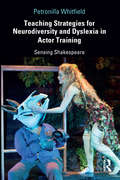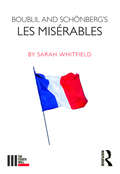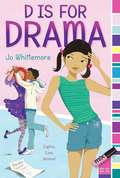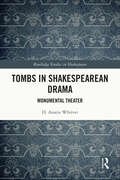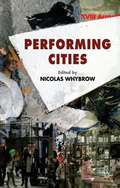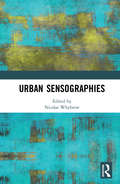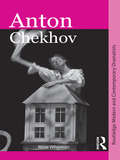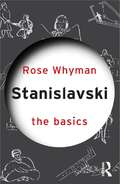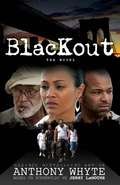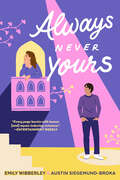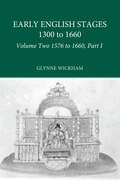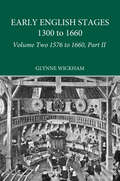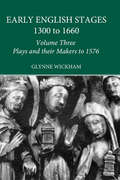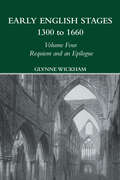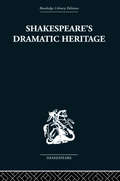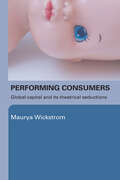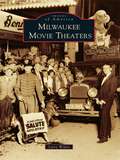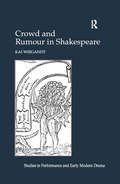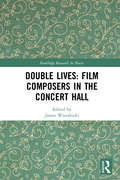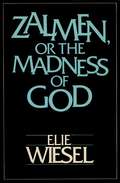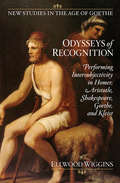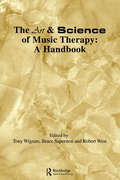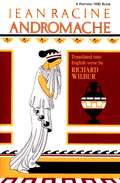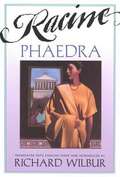- Table View
- List View
Teaching Strategies for Neurodiversity and Dyslexia in Actor Training: Sensing Shakespeare
by Petronilla WhitfieldTeaching Strategies for Neurodiversity and Dyslexia in Actor Training addresses some of the challenges met by acting students with dyslexia and highlights the abilities demonstrated by individuals with specific learning differences in actor training. The book offers six tested teaching strategies, created from practical and theoretical research investigations with dyslexic acting students, using the methodologies of case study and action research. Utilizing Shakespeare’s text as a laboratory of practice and drawing directly from the voices and practical work of the dyslexic students themselves, the book explores: the stress caused by dyslexia and how the teacher might ameliorate it through changes in their practice the theories and discourse surrounding the label of dyslexia the visual, kinaesthetic, and multisensory processing preferences demonstrated by some acting students assessed as dyslexic acting approaches for engaging with Shakespeare’s language, enabling those with dyslexia to develop their authentic voice and abilities a grounding of the words and the meaning of the text through embodied cognition, spatial awareness, and epistemic tools Stanislavski’s method of units and actions and how it can benefit and obstruct the student with dyslexia when working on Shakespeare Interpretive Mnemonics as a memory support and hermeneutic process, and the use of color and drawing towards an autonomy in live performance This book is a valuable resource for voice and actor training, professional performance, and for those who are curious about emancipatory methods that support difference through humanistic teaching philosophies.
Boublil and Schönberg’s Les Misérables (The Fourth Wall)
by Sarah Whitfield"One more dawn! One more day! One day more!" Did Les Misérables make you miserable? Or did it inspire you? When Sarah Whitfield was a teenager, her Dad frequently embarrassed her with his love of this musical above all others. So, after he was diagnosed with late stage cancer, Whitfield set out to find out why this musical meant so much to him and to its worldwide following. In this new book, she asked her Dad and 350 other people how they felt about this musical, exploring people’s personal connections with the show. In the middle of some of the hardest moments in family life, Whitfield explores how the musical might help us deal with some of our most difficult experiences and give us hope for when ‘tomorrow comes’.
D Is for Drama
by Jo WhittemoreA lead role means lots of drama in this sparkling story of one tween's efforts to shine in the spotlight. Sunny Kim is done with one-line roles at Carnegie Arts Academy--she's ready for the lead. But even after a summer of studying with an acting coach, Sunny doesn't snag the role of Mary Poppins in her school's upcoming production. Unfortunately, her entire family mistakenly thinks otherwise, including her former-actress mother. Desperate for a solution, Sunny convinces her theater adviser to let her produce a one-woman show. But when the rest of her friends find out--the friends that never seem to make the playbill either--they all want to join in. Before long, Sunny is knee-deep in curtains, catfights, and chorus lines as her one-woman work turns into a staging of the hit musical Wicked. And when a terrible misunderstanding pits the entire cast against Sunny, can the show--and Sunny's future acting career--be saved in time for opening night?
D Is for Drama
by Jo WhittemoreA lead role means lots of drama in this sparkling story of one tween's efforts to shine in the spotlight. Sunny Kim is done with one-line roles at Carnegie Arts Academy--she's ready for the lead. But even after a summer of studying with an acting coach, Sunny doesn't snag the role of Mary Poppins in her school's upcoming production. Unfortunately, her entire family mistakenly thinks otherwise, including her former-actress mother. Desperate for a solution, Sunny convinces her theater adviser to let her produce a one-woman show. But when the rest of her friends find out--the friends that never seem to make the playbill either--they all want to join in. Before long, Sunny is knee-deep in curtains, catfights, and chorus lines as her one-woman work turns into a staging of the hit musical Wicked. And when a terrible misunderstanding pits the entire cast against Sunny, can the show--and Sunny's future acting career--be saved in time for opening night?errible misunderstanding finds the entire cast raising a mutiny against Sunny, can the show--and Sunny's future acting career--be saved in time for opening night?
Tombs in Shakespearean Drama: Monumental Theater (Routledge Studies in Shakespeare)
by H. Austin WhitverTombs in Shakespearean Drama explores the rhetorical deployment of tombs and monuments on the early modern stage, demonstrating their historiographic power and mythmaking potential. By analyzing references to tombs in plays by Shakespeare and others in conjunction with extant monuments, this volume demonstrates how these references function in two overlapping ways in period drama: monuments act as repositories of information about the past, and they allow the living to construct and preserve fictive narratives. The stage exposes the flimsy materiality of paper, placing less value on the written word than period poetry. In this way, critics have perhaps oversold as universal Shakespeare’s poetic praise of stone. Tombs within plays act as a powerful historical and narrative medium, raising the stakes to provide the stage with the illusion of permanency. Playwrights use tombs to anchor the stage action, giving a sense of lasting importance to dramatic events and combatting the ephemeral nature of the playhouse. In drama, Shakespeare and others drew on the persona preserved on tombs; this volume widens our view of how these representations interacted in the commemorative economy of early modern England. Within the playhouse, it was the tomb, not the tome, that stood as a symbol of permanence.
Performing Cities
by Nicolas WhybrowPerforming Cities is an edited volume of contributions by a range of internationally renowned academics and performance makers from across the globe, each one covering a particular city and examining it from the dynamic perspectives of performances occurring in cities and the city itself as performance.
Urban Sensographies
by Nicolas WhybrowUrban Sensographies views the human body as a highly nuanced sensor to explore how various performance-based methods can be implemented to gather usable ‘felt data’ about the environment of the city as the basis for creating embodied mappings. The contributors to this fascinating volume seek to draw conclusions about the constitution, character and morphology of urban space as public, habitable and sustainable by monitoring the reactions of the human body as a form of urban sensor. This co-authored book is centrally concerned, as a symptom of the degree to which cities are evolving in the 21st century, to examine the effects of this change on the practices and behaviours of urban dwellers. This takes into account such factors as: defensible, retail and consumer space; legacies of modernist design in the built environment; the effects of surveillance technologies, motorised traffic and smart phone use; the integration of ‘wild’ as well as ‘domesticated’ nature in urban planning and living; and the effects of urban pollution on the earth’s climate. Drawing on three years of funded practical research carried out by a multi-medial team of researchers and artists, this book analyses the presence and movement of the human body in urban space, which is essential reading for academics and practitioners in the fields of dance, film, visual art, sound technology, digital media and performance studies.
Anton Chekhov (Routledge Modern and Contemporary Dramatists)
by Rose WhymanAnton Chekhov offers a critical introduction to the plays and productions of this canonical playwright, examining the genius of Chekhov's writing, theatrical representation and dramatic philosophy. Emphasising Chekhov’s continued relevance and his mastery of the tragicomic, Rose Whyman provides an insightful assessment of his life and work. All of Chekhov’s major dramas are analysed, in addition to his vaudevilles, one-act plays and stories. The works are studied in relation to traditional criticism and more recent theoretical and cultural standpoints, including cultural materialism, philosophy and gender studies. Analysis of key historical and recent productions, display the development of the drama, as well as the playwright’s continued appeal. Anton Chekhov provides readers with an accessible comparative study of the relationship between Chekhov's life, work and ideological thought.
Stanislavski: The Basics (The Basics)
by Rose WhymanStanislavski: The Basics is an engaging introduction to the life, thought and impact of Konstantin Stanislavski. Regarded by many as a great innovator of twentieth century theatre, this book examines Stanislavski's: life and the context of his writings major works in English translation ideas in practical contexts impact on modern theatre With further reading throughout, a glossary of terms and a comprehensive chronology, this text makes the ideas and theories of Stanislavski available to an undergraduate audience.
Blackout
by Anthony Whyte Jerry LamotheIt's August, 2003. All of the Northeast is sweltering, but no place is hotter than Brooklyn, especially the gritty neighborhood known as East Flatbush. Then, in the midst of the heat wave, the unthinkable happens: the power goes out. And stays out. And the longer it's out, the edgier people get, until finally, edginess gives way to anger. For 48 hours, the community is in chaos. Looters are everywhere. No one is safe. Violence erupts suddenly, randomly, scarring the innocents as well as the agitators, until Flatbush finally explodes into deadly conflict. Based on actual events that occurred during the Northeast Blackout of August 14-15, 2003, this riveting novel tells the little-known story of a neighborhood thrown not only into darkness, but utter mayhem. Illustrated throughout with scenes from the film, Blackout is a heart-stopping, page-turning drama that keeps readers unable to put it down.
Always Never Yours
by Emily Wibberley Austin Siegemund-Broka“An utterly charming story of love, family, heartbreak, and drama. I absolutely loved it!”—Morgan Matson, New York Times bestselling author of Since You’ve Been GoneMegan Harper is the girl before. All her exes find their one true love right after dating her. It's not a curse or anything, it's just the way things are. and Megan refuses to waste time feeling sorry for herself. Instead, she focuses on pursuing her next fling, directing theater, and fulfilling her dream school's acting requirement in the smallest role possible. But her plans quickly crumble when she's cast as none other than Juliet--yes, that Juliet--in her high school's production. It's a nightmare. No--a disaster. Megan's not an actress and she's certainly not a Juliet. Then she meets Owen Okita, an aspiring playwright who agrees to help Megan catch the eye of a sexy stagehand in exchange for help writing his new script. Between rehearsals and contending with her divided family, Megan begins to notice Owen--thoughtful, unconventional, and utterly unlike her exes, and wonders: shouldn't a girl get to play the lead in her own love story?
Part I - Early English Stages 1576-1600
by Glynne WickhamThis volume forms part of the 5 volume set Early English Stages 1300-1660. This set examines the history of the development of dramatic spectacle and stage convention in England from the beginning of the fourteenth century to 1660.
Part II - Early English Stages 1576-1600
by Glynne WickhamThis volume forms part of the 5 volume set Early English Stages 1300-1660. This set examines the history of the development of dramatic spectacle and stage convention in England from the beginning of the fourteenth century to 1660.
Plays and their Makers up to 1576
by Glynne WickhamThis volume forms part of the 5 volume set Early English Stages 1300-1660. This set examines the history of the development of dramatic spectacle and stage convention in England from the beginning of the fourteenth century to 1660.
Requiem and an Epilogue
by Glynne WickhamFirst published in 2002.This volume forms part of the 5 volume set Early English Stages 1300-1660. This set examines the history of the development of dramatic spectacle and stage convention in England from the beginning of the fourteenth century to 1660.
Shakespeare's Dramatic Heritage: Collected Studies in Mediaeval, Tudor and Shakespearean Drama
by Glynne WickhamShakespeare's Dramatic Heritage shows that the drama of Elizabethan and Jacobean England is deeply indebted to the religious drama of the Middle Ages and represents a climax, in secular guise, to mediaeval experiment and achievement rather than a new beginning. This is fully examined in terms of dramatic literature as well as in terms of theatres, stages and production conventions. The plays studied include: Richard II, A Midsummer Night's Dream, Hamlet, Macbeth, Coriolanus, The Winter's Tale and Marlowe's King Edward II.
Performing Consumers: Global Capital and its Theatrical Seductions
by Maurya WickstromPerforming Consumers is an exploration of the way in which brands insinuate themselves into the lives of ordinary people who encounter them at branded superstores. Looking at our performative desire to ‘try on’ otherness, Maurya Wickstrom employs five American brandscapes to serve as case studies: Ralph Lauren; Niketown; American Girl Place; Disney store and The Lion King; and The Forum Shops at Caesar’s Palace in Las Vegas. In this post-product era, each builds for the performer/consumer an intensely pleasurable, somatic experience of merging into the brand and reappearing as the brand, or the brand’s fictional meanings. To understand this embodiment as the way that capital is producing subjectivity as an aspect of itself, Wickstrom casts a wide net, drawing on: the history of capital’s relationship with theatre political developments in the United States recent work in political science, philosophy, and performance studies. An adventurous study of theatrical indeterminancy and material culture, Performing Consumers brilliantly takes corporate culture to task.
Milwaukee Movie Theaters: A Pictorial History Of Milwaukee's Movie Theaters (Images of America)
by Larry WidenPrior to World War II, there were 90 single-screen movie theaters in Milwaukee. By 1960, that number had been reduced by half. With the arrival of television for the home market, the golden age of the movie theater in Milwaukee was dead. Yet their ghosts continue to haunt the old neighborhoods. Churches, warehouses, stores, nightspots, and other businesses now occupy the former Tivoli, Paris, Roosevelt, and Savoy Buildings. Others are simply vacant hulks, decaying from the inside out. The Elite, Regent, Lincoln, and Warner are but a few of the many silent sentinels from the days when Milwaukee was in love with the movies.
Crowd and Rumour in Shakespeare (Studies in Performance and Early Modern Drama)
by Kai WiegandtIn this study, the author offers new interpretations of Shakespeare's works in the context of two major contemporary notions of collectivity: the crowd and rumour. The plays illustrate that rumour and crowd are mutually dependent; they also betray a fascination with the fact that crowd and rumour make individuality disappear. Shakespeare dramatizes these mechanisms, relating the crowd to class conflict, to rhetoric, to the theatre and to the organization of the state; and linking rumour to fear, to fame and to philosophical doubt. Paying attention to all levels of collectivity, Wiegandt emphasizes the close relationship between the crowd onstage and the Elizabethan audience. He argues that there was a significant - and sometimes precarious - metatheatrical blurring between the crowd on the stage and the crowd around the stage in performances of crowd scenes. The book's focus on crowd and rumour provides fresh insights on the central problems of some of Shakespeare's most contentiously debated plays, and offers an alternative to the dominant tradition of celebrating Shakespeare as the origin of modern individualism.
Double Lives: Film Composers in the Concert Hall (Routledge Research in Music)
by James WierzbickiDouble Lives: Film Composers in the Concert Hall is a collection of fifteen essays dealing with ‘iconic’ film composers who, perhaps to the surprise of many fans of film music, nevertheless maintained lifelong careers as composers for the concert hall. Featured composers include Erich Wolfgang Korngold, Franz Waxman, Miklós Rózsa, Bernard Herrmann, Nino Rota, Leonard Rosenman, and Ennio Morricone. Progressing in chronological order, the chapters offer accounts of the various composers’ concert-hall careers and descriptions of their concert-hall styles. Each chapter compares the composer’s music for films with his or her music for the concert hall, and speculates as to how music in one arena might have affected music in the other. For each composer discussed in the book, complete filmographies and complete works lists are included as appendices. Double Lives: Film Composers in the Concert Hall is accessible for scholars, researchers, and general readers with an interest in film music and concert music.
Zalman or the Madness of God
by Elie WieselAn interesting study of a rabbi's struggle against religious persecution in post-Stalin Russia.
Odysseys of Recognition: Performing Intersubjectivity in Homer, Aristotle, Shakespeare, Goethe, and Kleist (New Studies in the Age of Goethe)
by Ellwood WigginsLiterary recognition is a technical term for a climactic plot device. Odysseys of Recognition claims that interpersonal recognition is constituted by performance, and brings performance theory into dialogue with poetics, politics, and philosophy. By observing Odysseus figures from Homer to Kleist, Ellwood Wiggins offers an alternative to conventional intellectual histories that situate the invention of the interior self in modernity. Through strategic readings of Aristotle, this elegantly written, innovative study recovers an understanding of interpersonal recognition that has become strange and counterintuitive. Penelope in Homer’s Odyssey offers a model for agency in ethical knowledge that has a lot to teach us today. Early modern and eighteenth-century characters, meanwhile, discover themselves not deep within an impenetrable self, but in the interpersonal space between people in the world. Recognition, Wiggins contends, is the moment in which epistemology and ethics coincide: in which what we know becomes manifest in what we do. Published by Bucknell University Press. Distributed worldwide by Rutgers University Press.
Art & Science of Music Therapy: A Handbook
by Tony Wigram Robert West Bruce SaperstonFirst Published in 1995. Routledge is an imprint of Taylor & Francis, an informa company.
Andromache, by Racine
by Richard WilburA skillful translation of the classical French tragedy about the captivity of Hector's wife after her abduction by the son of Achilles. The rhymed couplets retain the simplicity of form and powerful language of the original. "[This translation] is a striking tour de force" (Hudson Review). Drawings by Igor Tulipanov.
Phaedra, by Racine
by Richard WilburPhaedra is consumed with passion for Hippolytus, her stepson. Believing her husband dead, she confesses her love to him and is rebuffed. When her husband returns alive, Phaedra convinces him that it was Hippolytus who attempted to seduce her. In his interpretation, Racine replaced the stylized tragedy with human-scale characters and actions. Introduction by Richard Wilbur.
